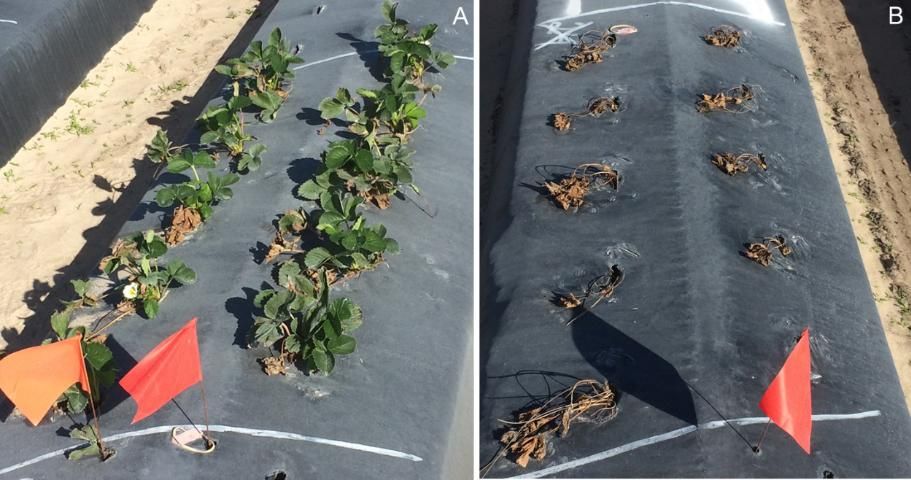Introduction
Phytophthora crown rot, caused mainly by Phytophthora cactorum, is an important disease in Florida strawberry fields. On average, about 30% of the strawberry crown rot samples received in the Plant Diagnostic Clinic located at the UF/IFAS Gulf Coast Research and Education Center (GCREC) are diagnosed with Phytophthora crown rot. Although P. cactorum is the most common species isolated from symptomatic plants, P. nicotianae has been recently identified as causing crown rot as well (Marin et al. 2018). These Phytophthora species also infect fruit under certain conditions and cause a fruit rot commonly called leather rot.
Causal Agent and Symptoms
Phytophthora species are filamentous “fungi-like” organisms classified as oomycetes, which are more closely related to brown algae than fungi. These organisms can produce asexual zoospores with flagella that allow them to move through water. The disease is characterized by a sudden wilting and collapse of plants in fruit production fields (Figure 1A). The internal crown of wilting plants shows brown-to-orange necrotic areas when cut open (Figure 1B). The wilt and crown rot symptoms caused by Phytophthora species are difficult to distinguish from those caused by other crown rot pathogens found in Florida, such Colletotrichum gloeosporioides and Macrophomina phaseolina. Since recommendations for disease management drastically differ according to each crown rot pathogen, samples should be submitted to a diagnostic clinic for pathogen isolation and identification of the pathogen.

Credit: UF/IFAS
Disease Development and Spread
In some pathosystems and locations, Phytophthora species can produce survival structures such as oospores, which can persist for years in the soil and plant debris. In Florida, based on surveys of infested fields, P. cactorum and P. nicotianae do not seem to survive in the soil over the summer (off-season). Thus, the primary source of inoculum for epidemics in Florida is likely quiescent-infected transplants from nurseries. Disease development is triggered under wet conditions. Hence, disease outbreaks commonly occur early in the season (October and November) when overhead irrigation, warm temperatures, and rapid juvenile growth favor the disease. The disease can also occur during the peaks of fruit production, particularly after high rainfall.
Control
Management of Phytophthora crown rot involves a combination of cultural and chemical control methods.
Cultural
In Florida, the combination of hot, wet summers and fall fumigation appears to be sufficient to prevent over-summer survival of inoculum. Thus, the best control of Phytophthora crown rot is to use disease-free transplants, if available.
Phytophthora crown rot incidence is usually lower in sites with improved soil drainage, which is more permeable to water.
Studies performed at UF/IFAS GCREC have shown that nursery transplants exposed to aerated steam in a closed chamber (i.e., a plant sauna) at 37°C (98.6°F) for 1 hour followed by 44°C (111.2°F) for 4 hours were much less likely to die from Phytophthora crown rot (Figure 2). Therefore, thermotherapy of transplants could be a good alternative for nurseries to manage Phytophthora populations in plant stock.

Credit: UF/IFAS
Cultivars differ significantly in their susceptibility to this disease. The old cultivar 'Strawberry Festival' was quite tolerant. Among currently grown cultivars, 'FL 127' Sensation™ is susceptible, whereas 'Florida Brilliance', ‘Florida Medallion’, and Pearl '16.78-109' are more tolerant but not resistant.
Chemical
In fruit production fields, the disease can be controlled by applications of metalaxyl or mefenoxam (Ridomil Gold®), oxathiapiprolin + mefenoxam (Orondis Gold®), or by potassium phosphite products such as Prophyt®, K-Phite®, and Fosphite®.
To prevent epidemics in fruiting fields where resistance is not present, mefenoxam and related products containing mefenoxam should be applied through the drip irrigation system immediately after plant establishment. A second application between 45 and 60 days after transplanting, usually at fruit set, has been shown to suppress disease development in studies conducted at the UF-GCREC.
Resistance to mefenoxam (Ridomil Gold®) has emerged, but it is still at low frequency and often linked to only a few nursery sources. To confirm resistance to mefenoxam, infected plant samples should be submitted to our diagnostic clinic for testing.
Orondis Gold® has been recently registered and is a good alternative as a first application in case mefenoxam-resistant strains are introduced with the transplants. The PHI (pre-harvest interval) of 28 days after soil applications limits its use for early in the season.
Fosetyl-aluminum and the phosphite products are considered low-risk for developing fungicide resistance and should serve as a useful tool for integrated management of Phytophthora crown rot caused by P. cactorum. However, they are not as effective against P. nicotianae, reinforcing the need for a correct diagnosis. Phosphite products can be applied by foliar spray or drip injection at 2- to 3-week intervals starting after completion of overhead irrigation for plant establishment. These products should not be tank-mixed with copper fungicides, adjuvants, or foliar fertilizers because the combination may burn the leaves.
References
Baggio, J.S., Marin, M. V., and Peres, N. A. 2021. Phytophthora crown rot of Florida Strawberry: Inoculum Sources and Thermotherapy of Transplants for Disease Management. Plant Disease 105: 3496-3502.
Marin, M. V., T. Seijo, M. S. Oliveira, E. Zuchelli, J. Mertely, and N. A. Peres. 2018. First Report of Phytophthora nicotianae Causing Crown Rot of Strawberry in the United States. Plant Disease 102: 1463.
M. V. Marin, T. E. Seijo, E. Zuchelli, N. A. Peres. 2021. Resistance to Mefenoxam of Phytophthora cactorum and P. nicotianae Causing Crown and Leather Rot in Florida Strawberry. Plant Disease 105: 3490-3495.
M. V. Marin, J. S. Baggio, P. P. Mello, N. A. Peres. 2023. Phosphite is more effective against Phytophthora Crown Rot and Leather Rot caused by Phytophthora cactorum than P. nicotianae. Plant Disease 107: 1602-1608.
M. V. Marin, T. Seijo, J. S. Baggio, V. Whitaker, N. A. Peres. 2023. Resistance of strawberry cultivars and effect of plant ontogenesis on Phytophthora cactorum and P. nicotianae causing crown rot. Plant Disease 107: 651-657.